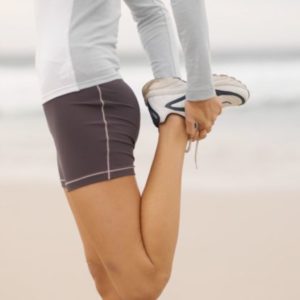 It’s one of many related questions raised every couple of years in the fitness industry with a dizzying medley of answers and conflicting opinions. When should we stretch? Before or after our workout/event/sport? How should we stretch? Statically? Dynamically? Why should we or shouldn’t we stretch? Will it negatively or positively affect my performance?
It’s one of many related questions raised every couple of years in the fitness industry with a dizzying medley of answers and conflicting opinions. When should we stretch? Before or after our workout/event/sport? How should we stretch? Statically? Dynamically? Why should we or shouldn’t we stretch? Will it negatively or positively affect my performance?
Let’s get some answers.
First, I want to discuss the basic types of stretching. Most commonly you will see people at the gym performing static stretches, or a stretch that you hold for anywhere from 20 to 90 seconds.
Static stretching. Often misunderstood to be the only way to stretch (less the occasional “bouncing” static stretchers- stop that!), and therefore an important thing to do before, after, or anytime during your workout. Not the case, but I will touch on that later.
Dynamic stretching. Involves moving in and out of a stretch in a fluid manner that foreshadows the movements you plan to make next. For example, if you have lunging in your program for that day, you might perform some walking lunges while raising your arms overhead. Think of dynamic stretching as a way to prepare your muscles for what is ahead.
PNF stretching. A third, less common but widely employed technique is called PNF stretching, or proprioceptive neuromuscular facilitation stretching, which uses both active and passive approaches to generate resistance in order to increase muscle elasticity. PNF stretching is becoming much more mainstream, being taken out of the clinic and into the gym. Coaches and trainers are learning these physical therapy techniques to improve range of motion and promote rehabilitation in their clients. An excellent book on the subject (if you are so inclined, or a super-geek like myself) is called ” The Genius of Flexibility”, by Bob Cooley.
Current research is suggesting that what we all thought we knew about stretching was, well, a stretch in and of itself. A study conducted at the University of Nevada, Las Vegas, found that when athletes engaged in static stretching during a warm-up, their muscles actually generated less force, or power, than those who did not stretch at all. Static stretching can actually decrease muscle strength by as much as 30%, according to other studies. Stretching while moving, or dynamic stretching, as a warm-up will increase blood flow to the muscles and literally warm them up.
“You need range-of-motion exercises that activate all of the joints and connective tissue that will be needed for the task ahead,” says Terrence Mahon, a coach with Team Running USA.
Physical therapist Eric M. Dinkins in Castle Rock, Colo., agrees.
“The type of stretching should be determined by the goals of the individual for each session to keep them safe and perform at their best,” says Dinkins. “If the intent is to create increased length of tissues, a prolonged, intense stretch for greater than 45 seconds is recommended with at least five repetitions. On the contrary, stretching to improve nerve mobility and decrease the initial nerve stretch response, is performed as a dynamic/quick reversal in which a stretch is felt by taking a muscle group quickly through a range of motion and then returning to the start position.”
As a yoga instructor myself since 1997, many of my clients are surprised at how little time I spend with them on traditional stretching. If you’ve read my column before, you already know that I am a big proponent of foam rolling as a way to stimulate bloodflow and healing processes. In addition to foam rolling, my clients first run through a battery of dynamic stretches, prepping their bodies with range of motion and activation. Only post-workout will I suggest light, static stretching to coax the poor, beat up muscles to elongate and heal.
“It is typically recommended that stretching for tissue lengthening [static] be reserved to either after a work out, as a separate regimen, or well before a desired activity,” says Dinkins.
So, the next time you are waiting for the big race to begin and you see countless runners holding their nose to their knees (or worse, stubbornly pulsing and straining to get their nose anywhere close to their knees), do not follow suit. Take strength in knowing what your body needs and when it needs it. Maybe even pass some of that knowledge along. After the race.
 Jodilyn Stuart is the owner of ModaBody Fitness and has been a fitness professional since 1997. She currently contributes to 303 Magazine as a Fitness and Health writer.
Jodilyn Stuart is the owner of ModaBody Fitness and has been a fitness professional since 1997. She currently contributes to 303 Magazine as a Fitness and Health writer.


